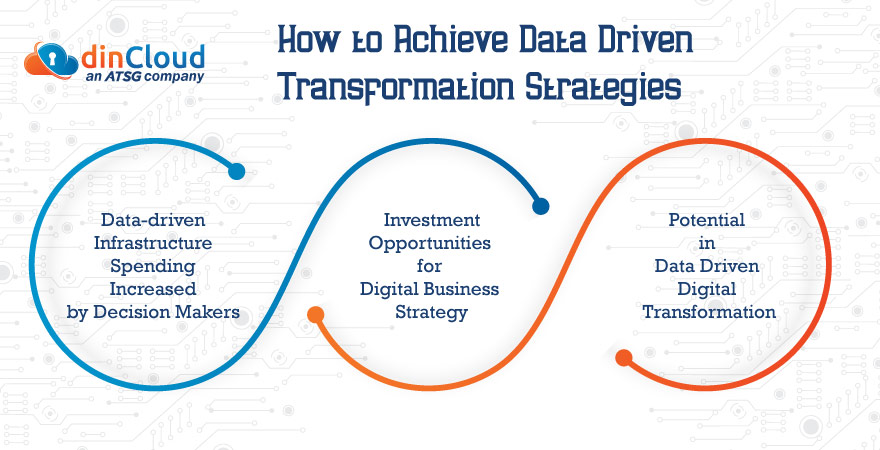There is a huge flux of data moving in and out of enterprises every day. Strenuous efforts are required for effective management of this data, and even minor discrepancies can cause inefficiencies. This can be mitigated by giving timely data access to required individuals. Responsive, scalable and resilient digital infrastructures will strengthen organizations’ agility and efficiency of operations. This will enable successful implementation of data operations and connectivity.
An accurate insight about data access, integration and analytics will further strengthen a business’s success and resilience.

Data-driven Infrastructure Spending Increased by Decision Makers
Now a days, businesses are operating in a very uncertain atmosphere. Onset of the global pandemic and consequent price spikes, inflation, supply chain disruption and instability in the geopolitical paradigm have made the situation complicated for almost all the industries. During this turbulent economic phase, businesses must have a robust digital business strategy and infrastructures for survival. According to IDC’s Global March FERS 2022 survey, 65% of the decision makers were worried about the global economic recovery, owing to the uncertainties of the international economic market.
Related: Data Lifecycle Management (DLM)
Business leaders are particularly concerned about the abrupt disruption in supply chains and spike in inflation. Nevertheless, it is not all doom and gloom, as 80% of them are planning on increasing their IT
Investment Opportunities for Digital Business Strategy
Today, modernization and digital integration have become a fundamental part of enterprise’s business strategy. Accurate and timely decisions making is important for successful execution of business agendas. It has become a global practice, for organizations, to invest in their multi-cloud and hybrid adoption strategies. Cloud-native infrastructure are now replacing the traditional on-premise infrastructures. The driving factor behind this migration is primarily the successful alignment of IT spending with business priorities. These include developers having timely access to scalable infrastructures and IT services.
In many instances, speed is given priority by decision makers in their business strategy formulation and investments have been made accordingly. Increasing number of businesses are now inclining towards cloud-based virtual migration because of cloud storage capacities and flexibility.
Related: Why is Cloud Data Lifecycle Management So Important for YOU?
Potential in Data Driven Digital Transformation
Seldom there arises operational friction, due to troubles in integration and coordination, across numerous data and application silos. This could act as a glitch in successful implementation of strategic digital programs and AI technologies across a wide range of formats and locations. To increase visibility across the cross-cloud control planes, DevOps and decisions makers can follow the following mentioned innovative steps.
New Generation Technology for Superior Cloud-Based Services
Infrastructure deployment choices are now workload-specific, because IT leaders want to have an optimized solution for Machine Learning (ML). This will be possible by inculcating specialized high performing silicon solutions in their infrastructure. This new generation technology will ease the data intensive workloads. Cloud service providers, like dinCloud, are giving democratized access to high performance computing services.
Dedicated Data Centers for Public Cloud
Public Cloud Service Providers are connected with third-party hosting and colocation provider locations. Private cloud, as a service, have connections with dedicated customer locations. Both of these are using the same control planes in Public Cloud Services. The seamless nature of this operational control plane has increased the strategic importance of Public Cloud Providers, as they have superior delivery capacities and incredible architectural impact.
Edge driven DataOps
Connection, analyzation and migration of data has been transformed drastically. Starting from edge to datacenters and then cloud, data is rapidly being proliferated in terms of its diversity. Edge data is gaining popularity and strategies are being formulated to successfully store, retain and protect it. Edge driven DataOps are important new disciplines.
Automation and AI/ML
The deployment and maintenance of digital infrastructure can be fundamentally transformed if AI/ML analytics and code-based self-operating automations become operationalized. IT teams will be able to simplify time-consuming tasks, keeping security, performance and compliance intact.
Wide-ranging ‘as-a-service’ sourcing
CSPs offer multifaceted IaaS solutions to their users. In return for these services, users pay fees. Today, there has been an increase in as-a-service models, providing software, hardware, management and security services. As-a-service options enable consistency in deployment and operations across the board. It also offers to layoff workloads from the on-premise employees, giving enterprise choice about deployment of workloads and data processing locations.
Related: A Paradigm Shift from Big Data to Small and Wide Data
Conclusion
The successful digital transformation entails a modular approach that is distributed by design, prioritizing deployment of workload, AI/ML automation, operations driven by policy and integrations enabled by APIs. The future of digital business transformation is bright, if we take full advantage of incorporating multi-cloud silos with modular and distributed designs.
If you are striving to lead in the business world and want to undergo smooth and flexible digital transformation, feel free to contact dinCloud, an ATSG company, for its robust dinHVD and dinDaaS services.


